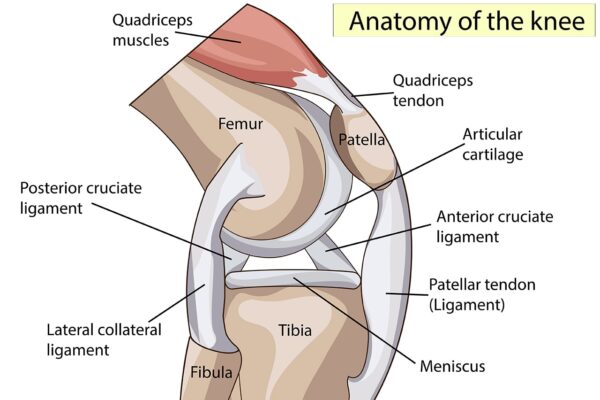Understanding The Common Causes Of Inner Knee Pain

Medically Reviewed By:
Inner knee pain is a common issue that affects individuals of all ages, from athletes to those with sedentary lifestyles. This discomfort can hinder daily activities and limit mobility. Understanding its causes, symptoms, and treatment options is crucial for managing the condition and maintaining knee health.
The Anatomy Of The Knee
The knee is a complex hinge joint that bears the body’s weight and facilitates movement. It comprises three main bones: the femur (thigh bone), tibia (shin bone), and patella (kneecap).
These bones are connected by ligaments and cushioned by cartilage, which allows smooth and stable motion. The knee is supported by key structures like the meniscus, tendons, and bursae, all of which play a role in its function and may cause pain when injured.
Anterior Cruciate Ligament (ACL)
Located in the center of the knee, the ACL prevents the tibia (the larger lower-leg bone) from shifting forward. The ACL also stabilizes the tibia during rotational movements. When loose, the ACL may allow rotational instability, resulting in pain.

Most physicians who examine the ACL are looking for catastrophic instability that would require surgery. Hence, what often gets missed are loose ligaments that, over time, can lead to problems.
Posterior Cruciate Ligament (PCL)
The PCL is situated behind the ACL and prevents the tibia from moving backward relative to the femur. This ligament stabilizes the knee during activities such as walking downhill or landing after a jump. Though less common than ACL injuries, PCL injuries can result in swelling and instability.
Medial Collateral Ligament (MCL)
The MCL runs along the inner side of the knee, connecting the femur to the tibia. It stabilizes the knee against forces from the outside and is prone to injury during twisting or impact. Symptoms of MCL injuries include localized pain, swelling, and restricted movement.
Other Symptoms That Indicate Inner Knee Conditions
Inner knee pain may occur with additional symptoms, which help diagnose the cause and guide treatment.
- Swelling: Inflammation along the inner knee is a common sign of irritation or injury.
- Clicking or Popping Sounds: Sounds during movement may suggest structural changes within the knee joint.
- Can’t Straighten the Knee: Knee extension lag occurs when the knee cannot fully straighten, often due to injury or muscle weakness, affecting mobility and strength.
The Most Common Causes Of Inside Knee Pain
Inner knee pain arises from various causes, including injuries and chronic conditions. Understanding these causes is the first step in addressing the pain and selecting appropriate treatment. Here are the most common causes of inside knee pain:
- Pes Anserine Bursitis: Pes anserine bursitis occurs when the tendons on the inner knee become damaged or the bursa near the inner knee becomes inflamed, resulting in pain and tenderness.
- Rheumatoid Arthritis: Rheumatoid arthritis causes inside knee pain due to joint inflammation and can lead to joint stiffness and reduced mobility.
- Medial Plica Irritation: Medial plica irritation is caused by inflammation of the plica (one of the folds in the knee membrane), leading to knee pain and a catching sensation during movement.
Key Diagnostic Tests
When a patient has an unstable knee, physicians typically perform a drawer test, which evaluates the tibia’s anterior stability but does not assess rotational stability. It is possible to have rotational instability even if the drawer test results are normal, meaning the knee may still lack full stability.
For example, a physician in the licensed Regenexx network highlighted a case where a patient had a normal drawer test.
The patient’s tibia appeared stable when pulled forward; however, further evaluation revealed rotational instability when the tibia was rotated and compared to the unaffected side. The patient had initially injured the ligament while skiing, and the rotational instability from this old knee injury caused significant complications over time.
Conventional Treatments For Knee Pain
Conventional treatments for inner knee pain focus on alleviating symptoms and restoring function. These treatments include:
- Physical Therapy: Physical therapy involves targeted exercises and stretches to strengthen muscles, improve flexibility, and support knee function.
- Non-steroidal Anti-inflammatory Drugs (NSAIDs): NSAIDs are commonly used to reduce inflammation and manage pain related to joint, muscle, or spine conditions, helping improve function.
- Knee Surgery for Meniscus Tears: Knee surgery for meniscus tears involves repairing or removing the damaged meniscus to alleviate pain and restore knee function.
Innovative Non-Surgical Regenexx Approach
Physicians in the licensed Regenexx network specialize in advanced, non-surgical treatment options designed to address the underlying causes of inner knee pain. These procedures use orthobiologics—natural substances derived from your body—to promote healing and improve knee function.
Examples include:
- Platelet-rich Plasma (PRP): Growth factors isolated from blood and injected to enhance tissue repair and reduce inflammation.
- Bone Marrow Concentrate (BMC): Contains stem cells and regenerative cells for repairing damaged tissues and improving ligament stability.
The Regenexx approach emphasizes precision and customization, enabling physicians to tailor orthobiologic methods to each patient’s unique condition. By utilizing advanced imaging technologies, such as ultrasound or fluoroscopy, physicians of the licensed Regenexx network ensure precise injection placement to optimize outcomes.
Promote Knee Health Without Surgery
Loose ACLs can usually be stabilized using a precise injection of orthobiologics, such as platelet-rich plasma (PRP) or bone marrow stem cells (BMC). For example, in the patient case referenced in the video, their bone marrow concentrate was harvested and injected to address the ACL issue. This approach has been used by physicians in the licensed Regenexx network for many years to help patients avoid unnecessary ACL surgery.
The location of knee pain and its underlying cause are often not the same. There’s frequently a disconnect between the source of the problem and where the pain is experienced. For example, if a drawer test comes back normal, but you are still experiencing front inside knee pain, addressing the underlying cause is essential. A prescription for pain medication is unlikely to resolve the issue.
Finding the root cause to address pain and prevent further damage is crucial. Are you experiencing inner knee pain? Find out if the Regenexx approach is right for you!

Medically Reviewed By:
